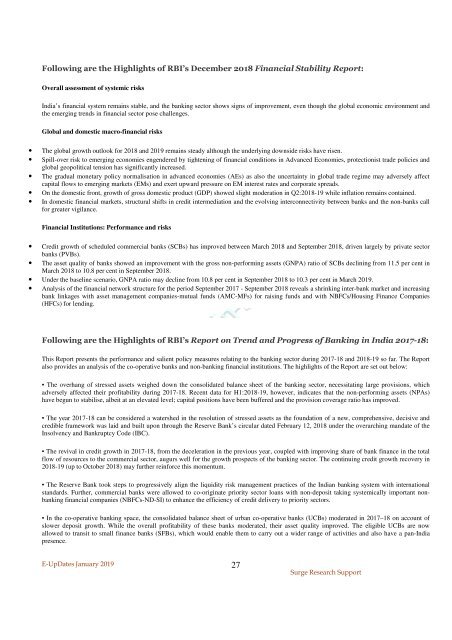E-UPDates—A Monthly Statistical Bulletin of Economic Indicators
The Monthly e-Bulletin for Economic/Financial Market Indicators— helps you and/or your students to stay informed about the Indian and global economy and financial markets.
The Monthly e-Bulletin for Economic/Financial Market Indicators— helps you and/or your students to stay informed about the Indian and global economy and financial markets.
You also want an ePaper? Increase the reach of your titles
YUMPU automatically turns print PDFs into web optimized ePapers that Google loves.
Following are the Highlights <strong>of</strong> RBI’s December 2018 Financial Stability Report:<br />
Overall assessment <strong>of</strong> systemic risks<br />
India’s financial system remains stable, and the banking sector shows signs <strong>of</strong> improvement, even though the global economic environment and<br />
the emerging trends in financial sector pose challenges.<br />
Global and domestic macro-financial risks<br />
• The global growth outlook for 2018 and 2019 remains steady although the underlying downside risks have risen.<br />
• Spill-over risk to emerging economies engendered by tightening <strong>of</strong> financial conditions in Advanced Economies, protectionist trade policies and<br />
global geopolitical tension has significantly increased.<br />
• The gradual monetary policy normalisation in advanced economies (AEs) as also the uncertainty in global trade regime may adversely affect<br />
capital flows to emerging markets (EMs) and exert upward pressure on EM interest rates and corporate spreads.<br />
• On the domestic front, growth <strong>of</strong> gross domestic product (GDP) showed slight moderation in Q2:2018-19 while inflation remains contained.<br />
• In domestic financial markets, structural shifts in credit intermediation and the evolving interconnectivity between banks and the non-banks call<br />
for greater vigilance.<br />
Financial Institutions: Performance and risks<br />
• Credit growth <strong>of</strong> scheduled commercial banks (SCBs) has improved between March 2018 and September 2018, driven largely by private sector<br />
banks (PVBs).<br />
• The asset quality <strong>of</strong> banks showed an improvement with the gross non-performing assets (GNPA) ratio <strong>of</strong> SCBs declining from 11.5 per cent in<br />
March 2018 to 10.8 per cent in September 2018.<br />
• Under the baseline scenario, GNPA ratio may decline from 10.8 per cent in September 2018 to 10.3 per cent in March 2019.<br />
• Analysis <strong>of</strong> the financial network structure for the period September 2017 - September 2018 reveals a shrinking inter-bank market and increasing<br />
bank linkages with asset management companies-mutual funds (AMC-MFs) for raising funds and with NBFCs/Housing Finance Companies<br />
(HFCs) for lending.<br />
Following are the Highlights <strong>of</strong> RBI’s Report on Trend and Progress <strong>of</strong> Banking in India 2017-18:<br />
This Report presents the performance and salient policy measures relating to the banking sector during 2017-18 and 2018-19 so far. The Report<br />
also provides an analysis <strong>of</strong> the co-operative banks and non-banking financial institutions. The highlights <strong>of</strong> the Report are set out below:<br />
• The overhang <strong>of</strong> stressed assets weighed down the consolidated balance sheet <strong>of</strong> the banking sector, necessitating large provisions, which<br />
adversely affected their pr<strong>of</strong>itability during 2017-18. Recent data for H1:2018-19, however, indicates that the non-performing assets (NPAs)<br />
have begun to stabilise, albeit at an elevated level; capital positions have been buffered and the provision coverage ratio has improved.<br />
• The year 2017-18 can be considered a watershed in the resolution <strong>of</strong> stressed assets as the foundation <strong>of</strong> a new, comprehensive, decisive and<br />
credible framework was laid and built upon through the Reserve Bank’s circular dated February 12, 2018 under the overarching mandate <strong>of</strong> the<br />
Insolvency and Bankruptcy Code (IBC).<br />
• The revival in credit growth in 2017-18, from the deceleration in the previous year, coupled with improving share <strong>of</strong> bank finance in the total<br />
flow <strong>of</strong> resources to the commercial sector, augurs well for the growth prospects <strong>of</strong> the banking sector. The continuing credit growth recovery in<br />
2018-19 (up to October 2018) may further reinforce this momentum.<br />
• The Reserve Bank took steps to progressively align the liquidity risk management practices <strong>of</strong> the Indian banking system with international<br />
standards. Further, commercial banks were allowed to co-originate priority sector loans with non-deposit taking systemically important nonbanking<br />
financial companies (NBFCs-ND-SI) to enhance the efficiency <strong>of</strong> credit delivery to priority sectors.<br />
• In the co-operative banking space, the consolidated balance sheet <strong>of</strong> urban co-operative banks (UCBs) moderated in 2017–18 on account <strong>of</strong><br />
slower deposit growth. While the overall pr<strong>of</strong>itability <strong>of</strong> these banks moderated, their asset quality improved. The eligible UCBs are now<br />
allowed to transit to small finance banks (SFBs), which would enable them to carry out a wider range <strong>of</strong> activities and also have a pan-India<br />
presence.<br />
E-UpDates January 2019<br />
27<br />
Surge Research Support










